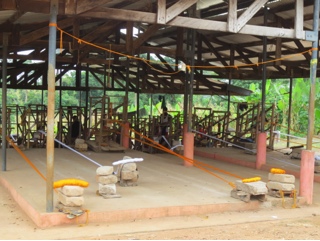Thanks to a fairly new visitors center with tour, Adanwomase is a great place to learn about kente and see kente cloth being made, as it is one of the five original kente villages. Often, I feel tours geared at visitors can be very gimmicky, but this tour was very authentic, interactive and informative. Our guide started by introducing us to the steps that have to be taken prior to weaving on the loom and explaining the meaning of the various colors and patterns used in kente. First, you have to spin your yarn--moving it from the skein to the cone. (See photo--Apparently, according to the guide, I had a natural talent for this...) Then, you must fold the thread to prepare it for the loom (see Derek walking near one end of the area and the 3 pegs are on the opposite side--where yarn is hooked). When finished, it should look something like the white/black/red yarn below. Finally, you're ready to weave!
Adanwomase has a community weaving project so all the money from the tours and the selling of Adinkra belong to the whole community, not just one person. They also have a community weaving workshop with several rows of loom after loom (see photos). The guide explained that men are the weavers (various reasons why women couldn't weave...mostly having to do with childbearing and cooking) and everyone in the village knows how to weave, starting around age 6! Considering the coordination necessary for weaving, I thought this was very impressive! Our guide demonstrated how to use the loom to weave (using both hands and both feet), and then it was our turn to try. He definitely made it look much easier than it was!
There are three types of weaving: simple (which we tried), double, and triple. The triple is very complicated and takes about a month to complete a set! I've included some pictures of each--
- simple: yellow with 4 black stripes and 1 red stripe that we tried weaving on
- double: green, yellow, red with diamond shapes and small vertical stripes
- triple: the most complicated-looking one with red, green, yellow, black and white
After seeing the workshop and trying weaving, our guide took us to a shop where we were dressed in traditional kente cloths (see photo!). It's important to know that kente is not everyday wear, as it's very heavy and hot to wear. It's used mostly for occasions--funerals, baby namings, festivals, etc.
One thing I loved about these tours was their authenticity. When we arrived to these villages, there weren't other tourists and the villages were making the inks, printing and weaving as normal. It is what they do everyday, not a show they put on for visitors. Also interesting to see was the funerals as we drove through the villages, as Saturday is the day for funerals. Funerals are big occasions and more celebratory than somber (...in fact, we were told many people meet their husband/wife at a funeral!) People mostly dress in traditional kente cloths in black, red and brown for funerals.
Time for bed! Tomorrow we will head to Kejetia market (West Africa's largest open-air market) and hopefully meet with the artist, BON, before heading to Tamale on Monday. Good night!












No comments:
Post a Comment
Thanks for taking the time to follow my trip and virtually share my experiences with me! Please say hello by writing a comment!